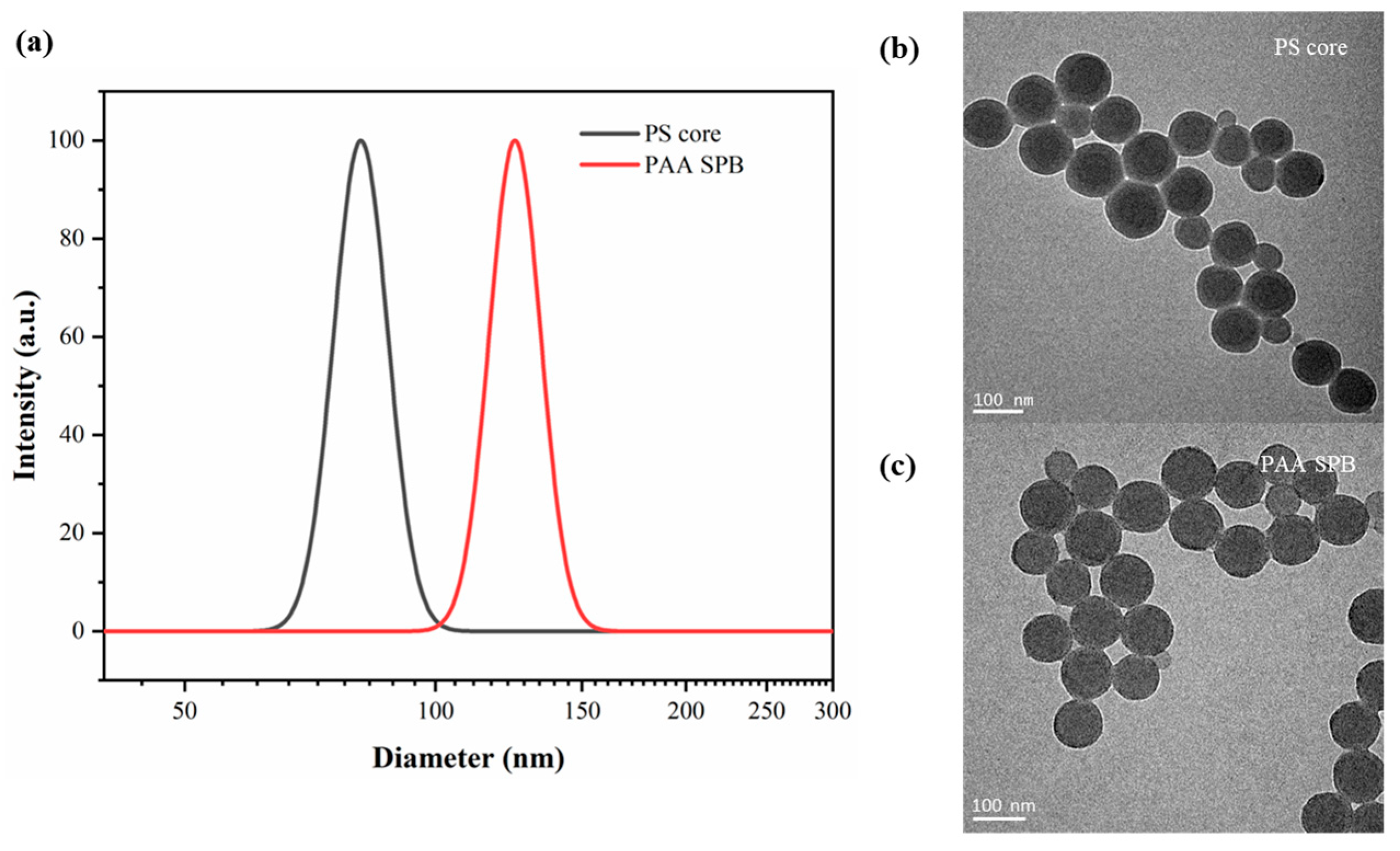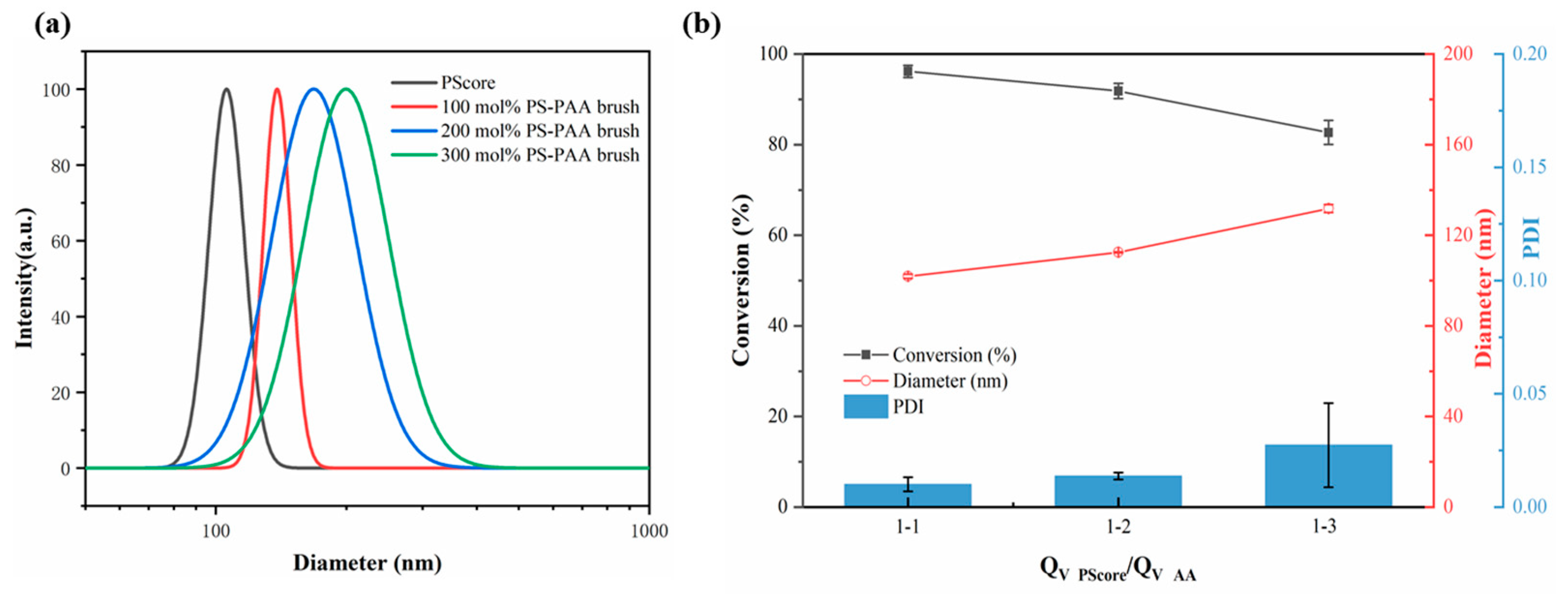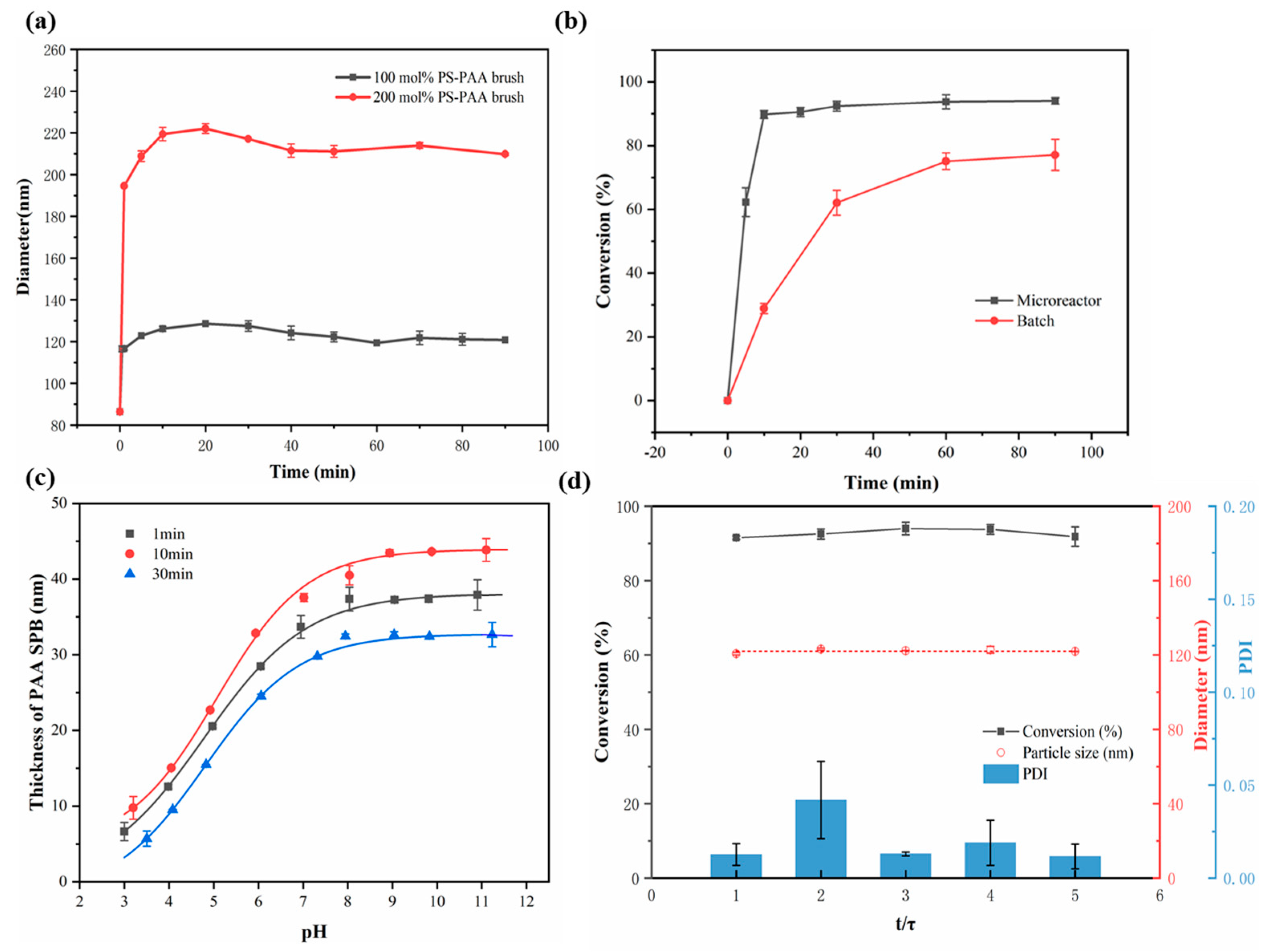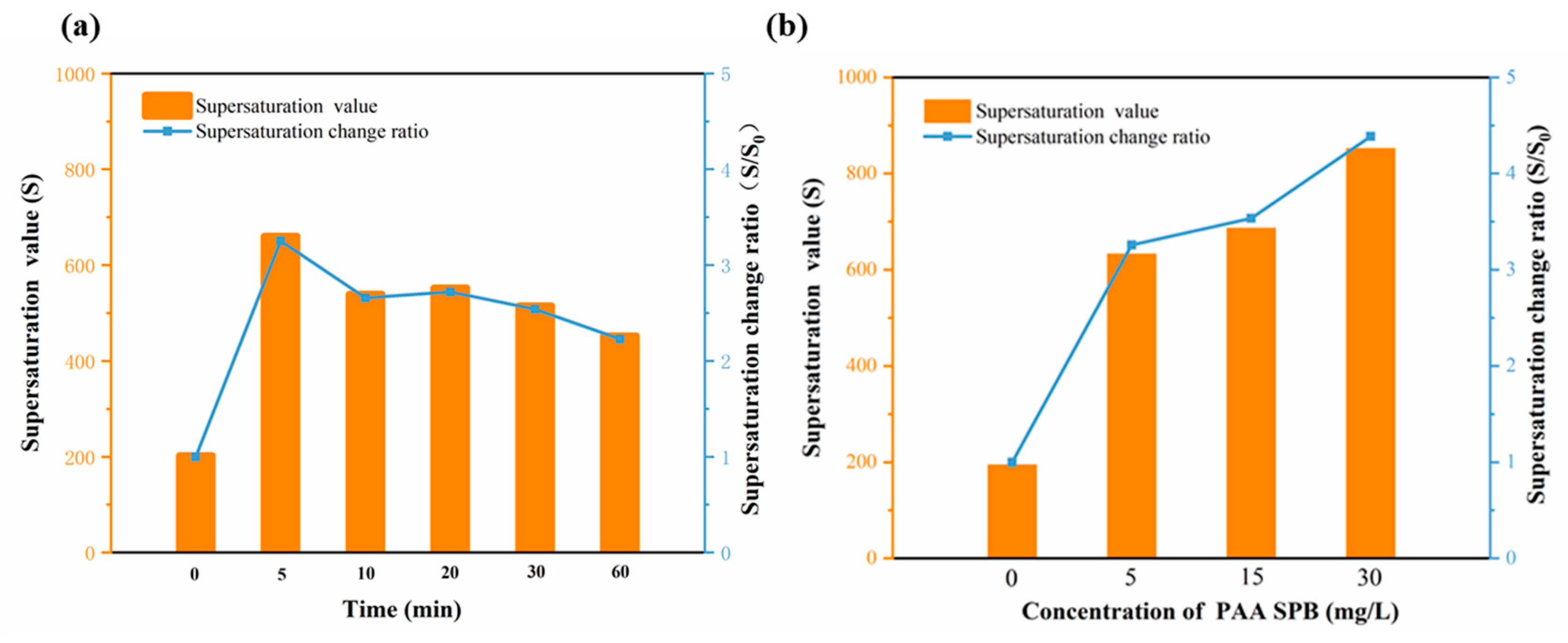Continuous Synthesis of Spherical Polyelectrolyte Brushes by Photo-Emulsion Polymerization in a Microreactor
Abstract
:1. Introduction
2. Materials and Methods
2.1. Materials
2.2. Setup of the Capillary Microreactor and Synthesis of SPBs
2.3. Investigation on the Conversion of Acrylic Acid
2.4. Characterization
2.5. Scale Inhibition Measurement
3. Results and Discussion
3.1. Preparation and Characterization of SPBs
3.2. Effect of Monomer Concentration
3.3. Effect of Residence Time
3.4. Versatility of SPB Synthesis in a Microreactor
3.5. Application of PAA SPBs in Scale Inhibition
4. Conclusions
Supplementary Materials
Author Contributions
Funding
Institutional Review Board Statement
Data Availability Statement
Conflicts of Interest
References
- Lu, Y.; Ballauff, M. Spherical polyelectrolyte brushes as nanoreactors for the generation of metallic and oxidic nanoparticles: Synthesis and application in catalysis. Progess Polym. Sci. 2016, 59, 86–104. [Google Scholar] [CrossRef]
- Yu, L.; Li, Z.W.; Hua, C.; Chen, K.M.; Guo, X.H. Temperature Responsive Diblock Polymer Brushes as Nanoreactors for Silver Nanoparticles Catalysis. Polymers 2023, 15, 1932. [Google Scholar] [CrossRef]
- Ezhova, A.; Huber, K. Contraction and Coagulation of Spherical Polyelectrolyte Brushes in the Presence of Ag+, Mg2+, and Ca2+ Cations. Macromolecules 2016, 49, 7460–7468. [Google Scholar] [CrossRef]
- Qian, W.; Zhu, Q.; Duan, B.; Tang, W.; Yuan, Y.; Hu, A. Electrostatic self-assembled nanoparticles based on spherical polyelectrolyte brushes for magnetic resonance imaging. Dalton Trans. 2018, 47, 7663–7668. [Google Scholar] [CrossRef]
- Sun, L.; Fu, Z.; Ma, E.; Li, L.; Liu, Z.; Guo, X. Bifunctional Polymer Brush Reactor for In Situ Synthesis of Hollow Silica-Supported Gold Nanocatalysts. Langmuir 2023, 39, 5454–5461. [Google Scholar] [CrossRef]
- Zheng, K.; Chen, Y.; Wang, X.; Zhao, X.; Xu, Y. Selective Protein Separation Based on Charge Anisotropy by Spherical Polyelectrolyte Brushes. Langmuir 2020, 36, 10528–10536. [Google Scholar] [CrossRef]
- Sybachin, A.V.; Zaborova, O.V.; Efimova, A.A.; Ballauff, M.; Yaroslavov, A.A. Electrostatic complexes of liquid and solid liposomes with spherical polycationic brushes. Polym. Sci. Ser. C 2017, 59, 60–67. [Google Scholar] [CrossRef]
- Walkowiak, J.; Lu, Y.; Gradzielski, M.; Zauscher, S.; Ballauff, M. Thermodynamic Analysis of the Uptake of a Protein in a Spherical Polyelectrolyte Brush. Macromol. Rapid Commun. 2020, 41, 1900421. [Google Scholar] [CrossRef]
- Wen, Y.; He, G.; Wang, Q.; Qin, W.; Guo, X.; Li, L. Exploration on the Application of Nano-Sized Spherical Polyelectrolyte Brush as Membrane Antiscalants for Wastewater Treatment. J. East China Univ. Sci. Technol. 2021, 47, 555. [Google Scholar]
- Solorzano, I.O.D.; Mendoza, G.; Arruebo, M.; Sebastian, V. Customized hybrid and thermoresponsive drug delivery microparticles synthetized by photopolymerization in a one-step flow focusing continuous microreactor. Colloids Surf. B Biointerfaces 2020, 190, 110904. [Google Scholar]
- Abdulla, H.M.; Howyeen, R.N.; Abid, M.F.; Hamod, A.S.; Hilal, M.H.; Sameer, A. Study on a Microreaction Process for Synthesis of Polyaniline. Int. J. Green Energy 2018, 15, 692–703. [Google Scholar] [CrossRef]
- Li, Z.; Zhang, P. Applications of microreactor in chemistry and chemical engineering. Chem. Ind. Eng. Prog. 2016, 8, 1648–1651. [Google Scholar]
- Luo, G.; Wang, K.; Lu, Y.; Xu, J.; Shao, H. Advances in research of micro-reactors. Xiandai Huagong/Mod. Chem. Ind. 2009, 29, 27–31. [Google Scholar]
- Yan, Z.; Tian, J.; Wang, K.; Nigam, K.D.P.; Luo, G. Microreaction processes for synthesis and utilization of epoxides: A review. Chem. Eng. Sci. 2021, 229, 116071. [Google Scholar] [CrossRef]
- Yadav, A.K.; de la Cal, J.C.; Barandiaran, M.J. Feasibility of Tubular Microreactors for Emulsion Polymerization. Macromol. React. Eng. 2011, 5, 69–77. [Google Scholar] [CrossRef]
- Song, Y.; Shang, M.; Li, G.; Luo, Z.H.; Su, Y. Influence of mixing performance on polymerization of acrylamide in capillary microreactors. AIChE J. 2018, 64, 1828–1840. [Google Scholar] [CrossRef]
- Zaquen, N.; Rubens, M.; Corrigan, N.; Xu, J.; Zetterlund, P.B.; Boyer, C.; Junkers, T. Polymer Synthesis in Continuous Flow Reactors. Prog. Polym. Sci. 2020, 107, 101256. [Google Scholar] [CrossRef]
- Gérardy, R.; Emmanuel, N.; Toupy, T.; Kassin, V.-E.; Tshibalonza, N.N.; Schmitz, M.; Monbaliu, J.-C.M. Continuous Flow Organic Chemistry: Successes and Pitfalls at the Interface with Current Societal Challenges. Eur. J. Org. Chem. 2018, 2018, 2301–2351. [Google Scholar] [CrossRef]
- Wenn, B.; Junkers, T. Continuous Microflow PhotoRAFT Polymerization. Macromolecules 2016, 49, 6888–6895. [Google Scholar] [CrossRef]
- Lobry, E.; Jasinski, F.; Penconi, M.; Chemtob, A.; Croutxé-Barghorn, C.; Oliveros, E.; Braun, A.M.; Criqui, A. Synthesis of acrylic latex via microflow miniemulsion photopolymerization using fluorescent and LED UV lamps. Green Process. Synth. 2014, 3, 335–344. [Google Scholar] [CrossRef]
- Gardiner, J.; Hornung, C.H.; Tsanaktsidis, J.; Guthrie, D. Continuous flow photo-initiated RAFT polymerisation using a tubular photochemical reactor. Eur. Polym. J. 2016, 80, 200–207. [Google Scholar] [CrossRef]
- Ramakers, G.; Krivcov, A.; Trouillet, V.; Welle, A.; Möbius, H.; Junkers, T. Organocatalyzed Photo-Atom Transfer Radical Polymerization of Methacrylic Acid in Continuous Flow and Surface Grafting. Macromol. Rapid Commun. 2017, 38, 1700423. [Google Scholar] [CrossRef]
- Ran, J.F.; Wang, X.X.; Liu, Y.H.; Yin, S.H.; Li, S.W.; Zhang, L.B. Microreactor-based micro/nanomaterials: Fabrication, advances, and outlook. Mater. Horiz. 2023, 10, 2343–2372. [Google Scholar] [CrossRef] [PubMed]
- Ballauff, M. Spherical polyelectrolyte brushes. Prog. Polym. Sci. 2007, 32, 1135–1151. [Google Scholar] [CrossRef]
- Guo, X.; Ballauff, M. Spatial Dimensions of Colloidal Polyelectrolyte Brushes as Determined by Dynamic Light Scattering. Langmuir 2000, 16, 8719–8726. [Google Scholar] [CrossRef]
- GB/T 16632-2019; Determination of Scale Inhibition Performance of Water Treatment Chemicals—Calcium Carbonate Precipiyation Method. Standardization Administration of the People’s Republic of China: Beijing, China, 2019.
- Li, A.; Zhang, H.; Liu, Q.; Zeng, H. Effects of chemical inhibitors on the scaling behaviors of calcite and the associated surface interaction mechanisms. J. Colloid Interface Sci. 2022, 618, 507–517. [Google Scholar] [CrossRef]








| AA (mol%) | Thickness of PAA SPBs (nm) | PDI | ||
|---|---|---|---|---|
| Batch | Microreactor | Batch | Microreactor | |
| 100 | 26 | 20 | 0.050 | 0.010 |
| 200 | 72 | 27 | 0.041 | 0.013 |
| 300 | 132 | 52 | 0.143 | 0.051 |
Disclaimer/Publisher’s Note: The statements, opinions and data contained in all publications are solely those of the individual author(s) and contributor(s) and not of MDPI and/or the editor(s). MDPI and/or the editor(s) disclaim responsibility for any injury to people or property resulting from any ideas, methods, instructions or products referred to in the content. |
© 2023 by the authors. Licensee MDPI, Basel, Switzerland. This article is an open access article distributed under the terms and conditions of the Creative Commons Attribution (CC BY) license (https://creativecommons.org/licenses/by/4.0/).
Share and Cite
Zhang, Z.; Zhang, Y.; Tian, Y.; Fu, Z.; Guo, J.; He, G.; Li, L.; Zhao, F.; Guo, X. Continuous Synthesis of Spherical Polyelectrolyte Brushes by Photo-Emulsion Polymerization in a Microreactor. Polymers 2023, 15, 4576. https://doi.org/10.3390/polym15234576
Zhang Z, Zhang Y, Tian Y, Fu Z, Guo J, He G, Li L, Zhao F, Guo X. Continuous Synthesis of Spherical Polyelectrolyte Brushes by Photo-Emulsion Polymerization in a Microreactor. Polymers. 2023; 15(23):4576. https://doi.org/10.3390/polym15234576
Chicago/Turabian StyleZhang, Ziyu, Yuhua Zhang, Yang Tian, Zhinan Fu, Jiangtao Guo, Guofeng He, Li Li, Fang Zhao, and Xuhong Guo. 2023. "Continuous Synthesis of Spherical Polyelectrolyte Brushes by Photo-Emulsion Polymerization in a Microreactor" Polymers 15, no. 23: 4576. https://doi.org/10.3390/polym15234576
APA StyleZhang, Z., Zhang, Y., Tian, Y., Fu, Z., Guo, J., He, G., Li, L., Zhao, F., & Guo, X. (2023). Continuous Synthesis of Spherical Polyelectrolyte Brushes by Photo-Emulsion Polymerization in a Microreactor. Polymers, 15(23), 4576. https://doi.org/10.3390/polym15234576







